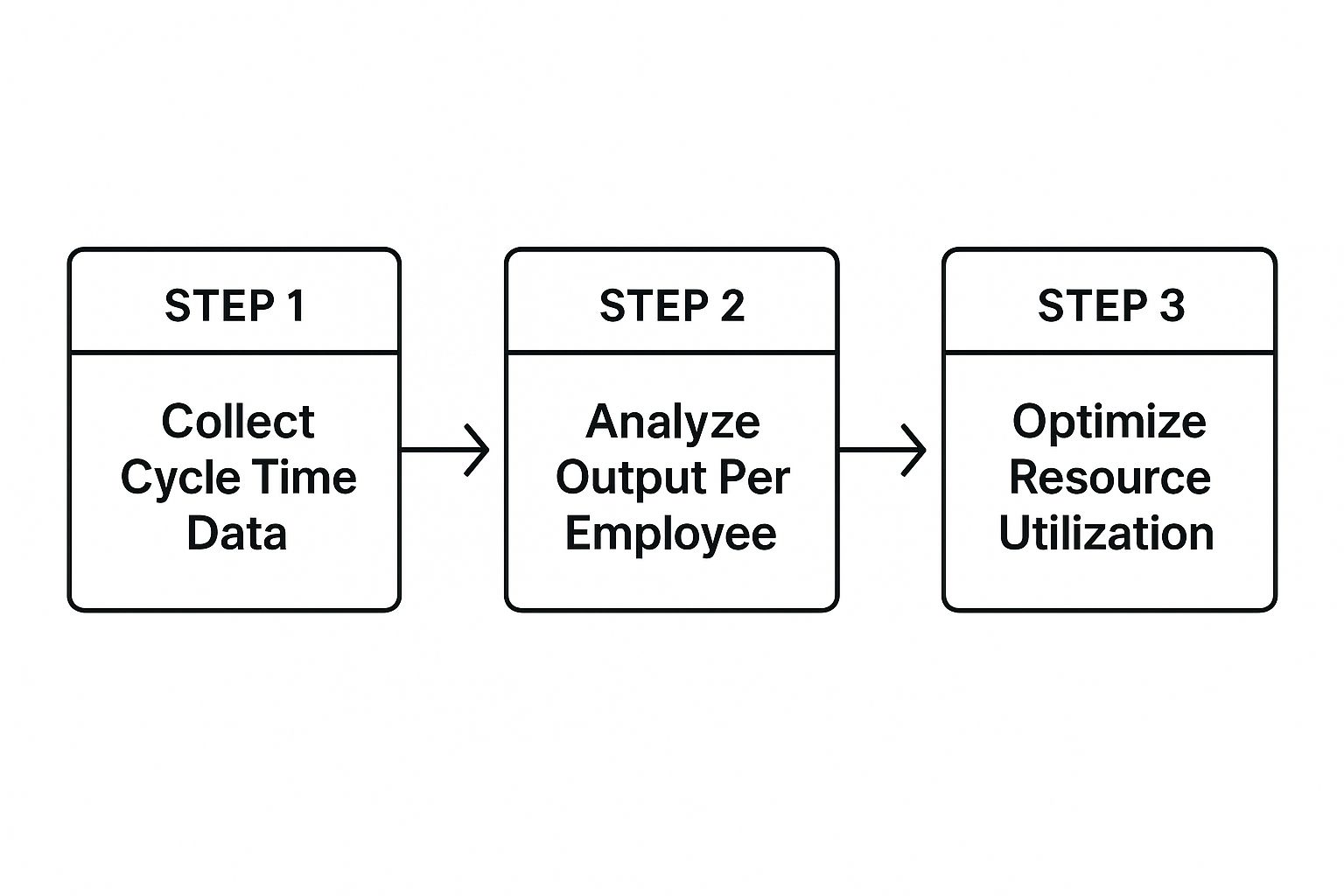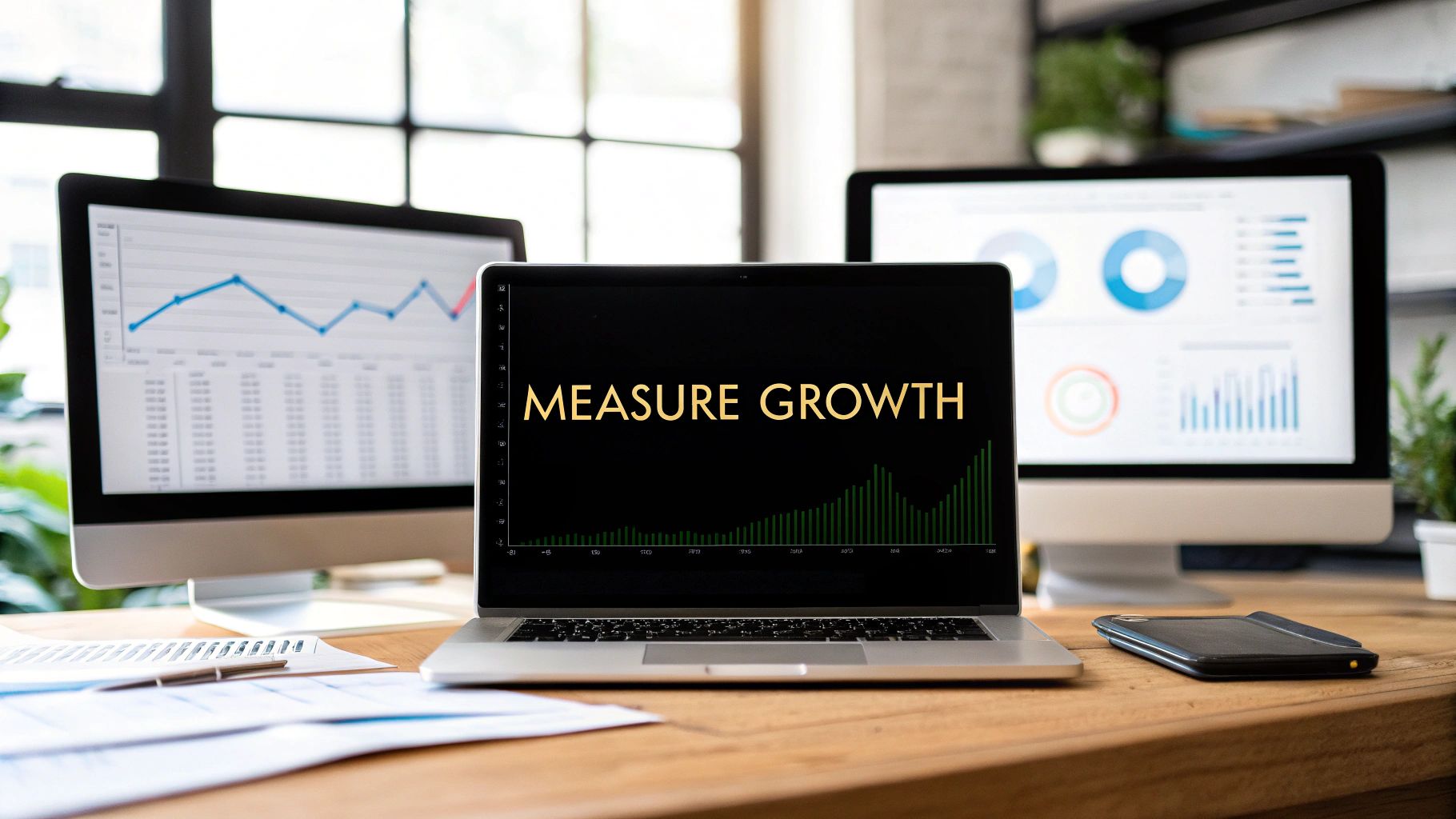How to Measure Business Growth Effectively
When people talk about business growth, the conversation almost always starts—and often ends—with revenue. It's the big, flashy number everyone loves to see go up. But fixating on revenue alone is like trying to drive a car by only looking at the speedometer.
Sure, you know how fast you're going, but what about the engine temperature? The fuel level? That weird rattling noise? Relying solely on revenue can mask serious problems brewing under the hood, like sky-high customer acquisition costs or a churn rate that's silently eating away at your future success.
Moving Beyond Revenue To Measure Real Growth
To get a true picture of your company's health, you need a dashboard, not just a single gauge. Sustainable, long-term growth is about balance. It’s about understanding the interconnected story your data is telling across every part of the business.
A sudden jump in sales might look fantastic on a chart, but if it came from a deep discount that tanked your profit margins and attracted one-time buyers, was it really a win? This is where a more sophisticated approach to measurement becomes critical.
The Problem With Vanity Metrics
It's easy to get caught up chasing vanity metrics. These are the numbers that feel good to report but don't actually mean much for the bottom line. Think massive social media followings that never convert, or a huge number of free sign-ups who never become paying customers.
The key is to shift your focus to actionable metrics—the numbers that give you real insight and help you make better decisions. These usually fall into a few core buckets:
- Financial Health: Are we actually profitable? Metrics like profit margin and Customer Lifetime Value (LTV) tell you if your growth is built on a solid foundation.
- Customer Loyalty: Are we keeping the customers we win? Churn rate and Net Promoter Score (NPS) are crucial for understanding customer satisfaction and retention.
- Operational Efficiency: Can our internal systems keep up? KPIs like revenue per employee help you see if you're scaling efficiently or just getting bigger and slower.
Setting A Baseline For Success
Context is everything. A 15% growth rate sounds impressive on its own, but if your entire industry is expanding by 30%, you're actually falling behind. You have to benchmark your performance to understand where you truly stand.
For a broad economic baseline, consider global trends. The International Monetary Fund, for instance, projects global economic growth at 3.0% for 2025 and 3.1% for 2026. If your business is consistently beating those numbers, you know you're doing something right. You can explore more about these global economic trends to get a better frame of reference for your own targets.
A business that only tracks revenue is flying blind. Real growth measurement is about creating a complete picture of company health—financial, customer-facing, and operational—to ensure your success is built to last, not just to impress.
By setting up this holistic view from day one, you build a powerful framework for decision-making. It’s the difference between guessing what works and knowing what drives real, sustainable success.
Before we dive into the specific metrics, here's a quick summary of the core areas you should be tracking to get that complete picture.
Core Growth Metrics at a Glance
| Metric Category | Key Metric | What It Measures |
|---|---|---|
| Financial Health | Revenue & MRR/ARR | Top-line income and recurring revenue streams. |
| Customer Value | LTV:CAC Ratio | The balance between customer lifetime value and acquisition cost. |
| Customer Loyalty | Churn Rate | The percentage of customers who leave over a specific period. |
| Operational Efficiency | Operational KPIs | How effectively internal processes support growth. |
This table serves as a high-level roadmap. Each category contains vital signs that, when monitored together, give you an accurate and actionable understanding of your business's trajectory. Now, let's break down how to track each one.
The Financial Metrics That Truly Matter

It’s easy to get fixated on top-line revenue. It’s the big, flashy number everyone asks about. But sustainable growth? That story is told in the finer details of your financial metrics.
Digging deeper than just sales figures is how you find out if your business is truly viable or just burning cash. These are the numbers that tell you how you're growing—sustainably or on a collision course. They're the leading indicators, the canaries in the coal mine that predict future success or warn you of trouble ahead.
Pinpointing Your Recurring Revenue
If you run a subscription-based business—think SaaS or a service agency on retainers—your world revolves around two key numbers: Monthly Recurring Revenue (MRR) and Annual Recurring Revenue (ARR). These aren't just one-off sales; they represent the predictable income you can count on.
But just tracking the total MRR or ARR isn't enough. You have to break it down.
- New MRR: This is revenue from brand-new customers.
- Expansion MRR: This comes from existing customers who upgrade or buy more.
- Churned MRR: This is the revenue you lose when customers cancel or downgrade.
Here's the secret: a healthy business isn't just adding new customers. It's keeping the ones it has happy enough to upgrade. When your expansion MRR consistently beats your churned MRR, you've found the holy grail of sustainable growth. It's a powerful signal that your product is delivering real, increasing value over time.
The LTV to CAC Ratio Explained
If I had to pick one metric to gauge the health of a growing business, it would be the Customer Lifetime Value (LTV) to Customer Acquisition Cost (CAC) ratio. It’s the ultimate gut check. This simple ratio tells you exactly how much a customer is worth to you over their lifetime versus what you paid to get them in the door.
A solid benchmark to aim for is a 3:1 ratio. For every dollar you spend on marketing and sales to land a new customer, you should be getting at least three dollars back over their lifetime.
A ratio below 1:1 is a five-alarm fire. You're literally paying to lose money on every new customer. On the flip side, a ratio of 5:1 or higher might mean you're being too conservative with your marketing spend and leaving growth on the table.
Let’s make this real. Say you spend $300 on ads to acquire one customer (CAC). If they pay you $50/month and stick around for two years, their LTV is $1,200. That gives you a healthy 4:1 LTV:CAC ratio. But what if they churn after just four months? Their LTV is only $200, and your ratio plummets to a painful 0.67:1. You just lost $100. This one calculation can completely change how you think about your marketing channels.
If you want to get into the weeds of digital marketing metrics like CPA, ROAS, and CTR, this guide on Key Performance Indicators for Digital Marketing is a great resource.
Profitability and Industry Benchmarks
Don't let revenue growth blind you to the bottom line. Profit margins are what separate a real business from a hobby. If your costs are ballooning faster than your sales, you're not building a business—you're building a bonfire for your cash. Keep a close eye on both your gross and net profit margins to make sure you're building an efficient, profitable machine.
Finally, give your numbers some context by stacking them up against industry averages. For established companies, a steady 5-10% annual growth rate is often considered quite healthy. Take the global business travel industry, for example, which is projected to hit $1.57 trillion in 2025 with a 6.6% growth rate. Knowing benchmarks like these helps you set targets that are ambitious but grounded in reality.
Gauging the Health of Your Customer Base

Your financials tell you what happened last quarter. But your customer metrics? They predict what’s going to happen next. A truly growing business is built on a foundation of happy, loyal customers who stick around. If that foundation is cracking, even the most impressive revenue charts are just a countdown to trouble.
That’s why getting a real pulse on your customer base is so critical. It’s about looking past the initial sale to see if you're actually building lasting relationships and delivering real value.
Understanding Your Churn Rate
The most brutal, honest measure of customer happiness (or unhappiness) is your churn rate. This is simply the percentage of customers who cancel their subscription over a given period. It's a vital sign for your business; a high churn rate puts you on a customer acquisition treadmill you can never win.
But it gets more nuanced than that. Not all churn is created equal, and it's essential to look at it from two different angles:
- Customer Churn: This is the straightforward count. If you start the month with 100 customers and 5 leave, your customer churn is 5%.
- Revenue Churn: This one tracks the percentage of revenue you've lost from existing customers. It’s a much clearer financial indicator because it includes downgrades along with full cancellations.
Think about it this way: you might lose five small customers but land a major upgrade from one enterprise client. Your customer churn is still 5%, but your net revenue churn could actually be negative. That’s a fantastic signal that your business is healthy and scalable.
For a deep dive into practical ways to keep your customers happy and your churn rate low, check out these powerful SaaS customer retention strategies to beat churn in 2025. Our detailed guide offers actionable steps you can implement right away.
Moving Beyond Numbers with Qualitative Feedback
While churn tells you what happened, qualitative feedback tells you why. These are the early warning signs—the leading indicators that can alert you to potential churn long before it hits your balance sheet.
The Net Promoter Score (NPS) is a classic for a reason. It boils down to one simple question: "On a scale of 0-10, how likely are you to recommend our business to a friend or colleague?" Based on the answer, you can immediately segment your entire customer base into three groups:
- Promoters (9-10): Your biggest fans and advocates.
- Passives (7-8): They're satisfied but not loyal. They're vulnerable to competitors.
- Detractors (0-6): Unhappy customers who are at risk of churning and could damage your brand.
This simple segmentation is incredibly powerful for understanding who your champions are and who is quietly slipping away.
Another crucial tool is the Customer Satisfaction (CSAT) score. You’ve seen these before—they’re usually sent right after a specific interaction, like resolving a support ticket or trying a new feature. CSAT asks customers to rate their satisfaction with that single experience.
By keeping an eye on CSAT scores, you can pinpoint specific friction points in your customer journey and fix them before they become big enough to cause a cancellation. When you combine these qualitative insights with hard data like your churn rate, you get a complete, actionable picture of your customer health.
Measuring Your Team and Operational Scalability

It’s easy to get tunnel vision on sales and revenue. But if you’re not careful, rapid growth can break your company from the inside out. True scalability isn’t just about landing more customers; it's about whether your team and your processes can actually handle the extra load without everything catching fire.
This is where operational metrics come into play. When your team is maxed out and internal systems start to fray, that exciting growth quickly becomes a massive liability. You need to keep a close eye on your internal KPIs to make sure the engine you're building can actually handle the speed you're going.
Revenue Per Employee: Your Efficiency Barometer
One of the cleanest ways to see if you're getting more efficient as you grow is to track Revenue Per Employee (RPE). It’s a dead-simple calculation: just divide your total revenue by your number of employees.
This number tells you exactly how much revenue each person on your team is helping to generate. As you scale, you want to see this number climb. If it's going up, it’s a great sign that your systems are working and you’re gaining real operational leverage. But if RPE starts to flatten or, worse, decline, it’s a major red flag. It often means you're hiring people faster than you're improving productivity, pointing to a bottleneck you need to fix ASAP.
Don't Forget the People Powering Your Growth
A revolving door of employees is a silent killer of growth. It's not just a morale problem; high turnover is a huge financial leak from recruiting costs, lost knowledge, and the time it takes to get new hires up to speed. That's why employee engagement and retention are non-negotiable growth metrics.
So, how do you keep a pulse on this? A few key metrics can tell you a lot:
- Employee Net Promoter Score (eNPS): Just like you ask customers if they'd recommend you, ask your team how likely they are to recommend your company as a place to work. It's a fantastic leading indicator of internal health.
- Voluntary Turnover Rate: This is the hard number. Tracking the percentage of people who choose to leave tells you exactly how well you're holding onto your talent.
- Absenteeism Rates: If you see a sudden jump in people calling out sick, it can be a symptom of burnout or low morale that needs to be addressed.
Keeping your team happy and engaged is especially critical when you're managing a distributed workforce. We've put together some practical advice on this in our guide on how to manage remote teams.
Neglecting team health in the pursuit of growth is a classic short-sighted mistake. Happy, engaged employees are more productive and innovative, which feeds directly back into your bottom line.
Looking at the bigger picture, these internal trends mirror what’s happening globally. The World Economic Forum projects that about 22% of current jobs will be impacted by structural changes in the next five years, with an overall net job growth of 7%. This just underscores how business expansion and workforce dynamics are two sides of the same coin. You can find more details on these job market shifts on weforum.org.
Building Your Growth Measurement Dashboard
Having the right metrics is only half the battle. If your data is scattered across a dozen different spreadsheets and platforms, you’re not really measuring growth—you’re just collecting numbers. What you need is a centralized growth dashboard, a single source of truth that turns all that raw data into a clear, actionable story.
This isn't about creating some intimidating wall of charts that only a data scientist could love. It’s about building a simple, visual command center for your business. The entire point is to see your most important KPIs at a glance, so you can spot trends, identify problems, and make smart decisions in minutes, not hours.
Choosing the Right Dashboard Tool
Look, you don't need to shell out for an expensive, enterprise-level solution to get started. There are plenty of powerful tools out there for businesses of all sizes, each with its own sweet spot.
- Google Data Studio (now Looker Studio): Honestly, this is the best starting point for most people. It’s free, it plays nicely with other Google products like Analytics and Sheets, and it’s intuitive enough for non-analysts to build something genuinely useful.
- Tableau: If you're juggling more complex data from multiple sources—say, a CRM, a backend database, and various marketing platforms—Tableau is a powerhouse. It offers much deeper analytical muscle, but be prepared for a steeper learning curve and a bigger price tag.
For most growing businesses, starting with Looker Studio is the pragmatic move. You can connect your key data sources and get a powerful dashboard up and running without spending a dime.
Designing a Dashboard That Actually Tells a Story
A great dashboard isn’t just a random collection of charts; it's a visual narrative that immediately draws your eye to what matters. The trick is to arrange your metrics logically so they answer your most pressing business questions.
The purpose of a dashboard isn't to just display data. It's to spark conversation and drive action. If a chart doesn't make you ask, "Okay, what should we do next?", it's probably just noise.
Start with your highest-level outcomes right at the top. Think of this as your "at a glance" section, featuring the big dogs: MRR growth, net profit, and your LTV:CAC ratio. From there, you can drill down into the metrics that directly influence them. For example, right below your MRR chart, you could show its drivers: new trials, conversion rates, and churn.
This simple flow shows how you can connect what your team does every day to the optimization efforts that actually move the needle.

When you visualize the process this way, it becomes much easier to connect team activities directly to the measurable efficiency gains you’re tracking.
Automate and Iterate
The real magic of a dashboard happens when you automate it. Manually updating spreadsheets every week is not only a drag but also a recipe for errors. Set up your tools to pull data automatically so your dashboard is always current.
This kind of setup is a perfect example of how you can score major efficiency wins. To dig deeper, you can explore the top business process automation benefits in our detailed guide.
And remember, your first dashboard won't be your last. It shouldn’t be. As your business evolves, your priorities will shift, and your dashboard needs to keep up. Revisit it every quarter and ask yourself: Are these still the most critical metrics for us right now? What new questions do we need to answer? This constant tweaking ensures your dashboard remains a vital, relevant tool for steering your growth.
Common Questions About Measuring Growth
Getting into the weeds of growth metrics can feel like a lot, especially when you’re first trying to build a system that actually works. It's totally normal for questions to pop up once you start putting theory into practice. Let's tackle some of the most common issues I see business owners run into.
One of the first hurdles is just getting the timing right. You don't want to be glued to your dashboard, reacting to every tiny dip and spike. But if you wait too long to check in, you could miss a major problem brewing under the surface. It’s all about matching your review schedule to the metric itself.
How Often Should I Review My Growth Metrics?
Honestly, it really depends on the metric. You wouldn’t check your annual profit margin every morning, and you wouldn't check your website traffic just once a year. The best way I've found to manage this is to group them by how fast they move.
-
Daily or Weekly Checks: These are for your fast-twitch, operational numbers. Things like daily sales, website sessions, or new trial sign-ups. They give you a real-time pulse on your day-to-day marketing and sales efforts.
-
Monthly or Quarterly Reviews: Save this cadence for the bigger, more strategic stuff. Metrics like your LTV:CAC ratio, overall churn rate, and profit margins need a longer time frame to show you real, meaningful patterns.
The whole point is to find a rhythm that feels predictable. You want to be able to make informed decisions without getting bogged down by statistical noise.
What Is the Single Most Important Metric for a Startup?
There's no single magic number that works for every startup, but if I had to point founders in one direction, it would be toward MRR growth rate and customer churn. Think of them as two sides of the same coin.
Your MRR growth proves you have a product people want and a revenue stream you can count on—which is everything for a subscription business. At the same time, keeping your churn low shows that the customers you're working so hard to acquire are actually sticking around because they see the value.
A healthy balance between getting new customers and keeping the ones you have is the core formula for survival. If you're great at one but terrible at the other, you're just pouring water into a leaky bucket.
My Revenue Is Growing but Profit Is Not. What Should I Look At?
This is a classic—and dangerous—growth trap. When revenue is climbing but profit is staying flat or even shrinking, it's a huge red flag that your business is getting less efficient as it gets bigger. You need to dig into your costs, and you need to do it now.
The first place to look is your Customer Acquisition Cost (CAC). Are your marketing and sales channels getting more expensive? Is it simply costing you too much to land each new customer?
Next, take a hard look at your Gross Margin. This will tell you if the cost to deliver your product or service is creeping up. Finally, scan your operational expenses for any bloat. A simple metric like revenue per employee can tell you a lot about whether your team's productivity is keeping up with your growth.
Ready to stop guessing and start building a scalable, efficient growth engine? The team at MakeAutomation specializes in implementing the AI and automation frameworks that slash costs, streamline operations, and put your business on the fast track to 7-figures. Learn how we can optimize your workflows today.







